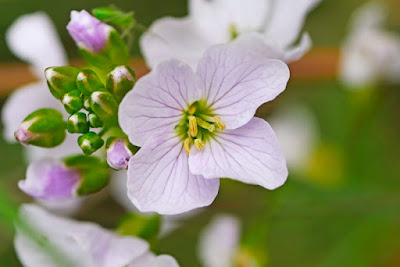It might seem like I just go out at random and find amazing plants. That is the case on some occasions, but I also try and plan some trips to target new species and these plans do not always come to fruition. One species I really wanted to see was the tiny Yellow Centaury, a very rare relative of Common Centaury. It grows on the heaths near the Lizard, so I made a return trip in mid June to try and find it. I didn't find any. This shows that plans don't always work out. The ground was very dry and parched and Yellow Centaury is an annual plant. So any that germinated early would have been droughted and died off. The rain of the previous week might bring new plants up, but I was too early to see them. However, I did find some other amazing plants as shown below.
I had seen Wild Chives near Kynance Cove, so I was surprised to find a patch well inland on Goonhilly Downs, but here they are!
Allium shoenoprasm
Heather coming into flower is a sign that Summer has arrived. I found a few just starting to flower.
Calluna vulgaris
These Common Centaury were rather droughted, so were very small. Sometimes they can look like Lesser Centaury, but if there is a (usually withered) rosette at the base it cannot be Lesser.
Centaurium erythraea
I walked past maybe 100 orchids before I gave in and photographed one. In Cornwall, there are very few Common Spotted Orchids, here they are nearly all Heath Spotted Orchids which favour acidic soils. However, with all the Southern Marsh Orchids around, I always look for hybrids though none were found here this day.
Dactylorhiza maculata
Dropwort grows on these Downs too, a very rare plant in Cornwall.
Filipendula vulgaris
I am still surprised when I find Yellow Bartsia here, but it is native in Cornwall, so that surprise should wear off soon! Here's a patch of them by a damp area on Goonhilly Downs.
Like it's cousin, Red Bartsia, it is a semi-parasite and takes nutrients from nearby plants.
Parentucellia viscosa
The last plant of note I found was a solitary Heath Fragrant Orchid, always a delight to find and smell.
Gymnadenia borealis
I also visited the coastal town of Portreath the same day to make the most of the petrol used in getting to the Lizrd area. Here I looked for Irish Spurge and Greater Broomrape, and again I failed to find both. For the former, I couldn't work out how to get into the wood they were growing in and for the latter, the habitat has now scrubbed over and the host plants missing. I did find other plants of interest, so here they are.
The shady conditions along the old tram path that I followed favoured Stinking Iris, just coming into flower. The name is derived from the rotting meat smell the plant gives off if you break a stem. The flower itself is odourless.
Iris foetidissima
Whilst looking for Greater Broomrape I did find some of the commoner Ivy Broomrape which parasitises Atlantic Ivy here.
Orobanche hederae
I had seen Wild Madder just once in Kent, before I moved to Cornwall. It was at Folkestone Warren and was in seed. So when I came here, where it is quite common, I was delighted to find some in flower for the first time. They are quite small compared to the large bristly leaves and not very obvious as the whole plant wraps itself through hedges and often isn't that easy to spot.
Rubia peregrina
A Cucumber Orb Spider and a Large Skipper Butterfly finished off an eventful day.
This week, I was also very fortunate to have been invited to a very large private meadow near Bodmin. Pictured is the land manager on the left and the VC2 County Recorder on the right. This whole area receives a once yearly cut with the findings taken away. The result is staggering with hundreds of Greater Butterfly and Southern Marsh Orchids present along with a host of other plants. A real delight to see.
Some of the Greater Butterfly Orchids from that site.
Platanthera chlorantha
Southern Marsh and Greater Butterfly Orchids, side by side, what a treat.
Platanthera chlorantha and Dactylorhiza praetermissa
With probably over a thousand Southern Marsh Orchids, that greatly increases the chances of variants and hybrids. Both were found. Here's an all white Southern Marsh Orchid. Unfortunately I missed it in its prime.
Several hybrids were also spotted. The parents being Heath Spotted and Southern Marsh Orchid. These were easy to spot being around two feet tall, though around them were also hybrids that were the usual size of under one foot tall.
D. x hallii
As I was near Bodmin, I took a small detour on the way home to the Moor near Cardinham to look for Moonwort fern. I didn't find these either, but I did find some very tiny Adder's Tongue, another tiny fern. It's leaf is to the far right of the photo. They are this small due to intensive grazing by sheep. Note the neatly cut off grasses in the photo too.
Ophioglossum vulgatum
It's a cold, harsh climate on Bodmin Moor and this is reflected by this Cuckooflower still being in full flower (as were many others here). In the lowlands these are now a distant memory awaiting next Spring to arrive.
Cardamine pratensis
I still haven't written up all of mid June, but this blog is now getting overlong, so I will end it here and do a Part 3 soon. Of course, June is probably the peak month for our flowering plants, so that should perhaps be expected.
Regards
Dave
@Botany2021


























































